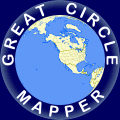Featured Map for 2 April 2017:
Aurora Australis "Flight to the Lights" on Air New Zealand
Just after 9 pm on 23 March 2017, Air New Zealand flight NZ 1980 "Flight to the Lights" departed Dunedin on a charter flight to chase the Aurora Australis or Southern Lights. Pairs of economy-class seats cost NZ$3,950 (about US$2,800; pairs in business class were NZ$8,500) but sold out quickly. They were sold in pairs to avoid issues with strangers arguing over window-seat time. Seats in the middle of the 767's 2-3-2 economy configuration were not sold.
The 134 passengers got their money's worth with amazing views for about half of the eight-hour flight at altitudes between FL370 and FL390. The Facebook group and news articles referenced below include a number of photos and videos taken during the adventure.
The flight was operated with Boeing 767-300ER ZK-NCG, which after returning to Auckland flew two more trips (AKL-RAR-SYD and return and then an AKL-MEL round-trip) before being retired, leaving just one 767 (ZK-NCI) remaining in Air New Zealand's fleet. (ZK-NCI closed the 767 era at Air New Zealand upon completing NZ 108 SYD-AKL four minutes before midnight at the end of the month.)
Today's Featured Map is based on flight-plan data posted by Captain Matthew Harrington. The clockwise flight path is depicted in the green, 558-nanometer wavelength emitted by excited oxygen, a color which dominates most terrestrial aurorae. Thanks to Ross Younger for the map idea!
This map uses a couple of hacks, er, tricks:
- Polar-aspect orthographic maps, i.e., orthographic projections centered on the north or south pole, are currently oriented with 0º longitude at the top of the map. This often isn't optimal but figuring out the "best" rotation isn't quite as easy as it seems for all cases, thus fixing this issue remains a work-in-progress. For today's map, an (oblique-aspect) orthographic projection is used with the center at 90ºS and with the longitude of Dunedin, placing Dunedin at the top of the map.
- Parallels, i.e., lines of constant latitude (and lines of constant longitude) are also on the wish list, along with lat/lon grids. For now, the Antarctic Circle was generated by calculating the distance from the South Pole to 66º33'46.3" S and using that distance in a range centered at the South Pole, with a similar process used to draw the 45ºS parallel.
References and additional information:
- Air New Zealand
- Flight to the Lights – Facebook group
- NZ1980 Flight to the Lights – Google Maps
- Aurora Australis From Flight NZ1980 23-24 March 2017 – YouTube
- Southern Lights put on show for passengers on special flight – CNN (27 March 2017)
- Video: Sky-high aurora light show – Otago Daily Times (24 March 2017)
- Southern lights sky-high over Dunedin in NZ – news.com.au (24 March 2017)
- Auroral Colors and Spectra – Windows to the Universe
- ZK-NCG Air New Zealand Boeing 767-319(ER)(WL) - cn 26912 / 509 – Planespotters.net
- ZK-NCG - 23-Mar-2017 - DUD / NZDN - DUD / NZDN - FlightAware – FlightAware
- ZK-NCI - 31-Mar-2017 - SYD / YSSY - AKL / NZAA - FlightAware – FlightAware
|
Information on this site may not be accurate or current and is not valid for flight planning or navigation. No warranty of fitness for any purpose is made or implied. Flight planning and navigation should only be done using official charts.
Copyright © 2010-2024
Karl L. Swartz.
All rights reserved.
|
